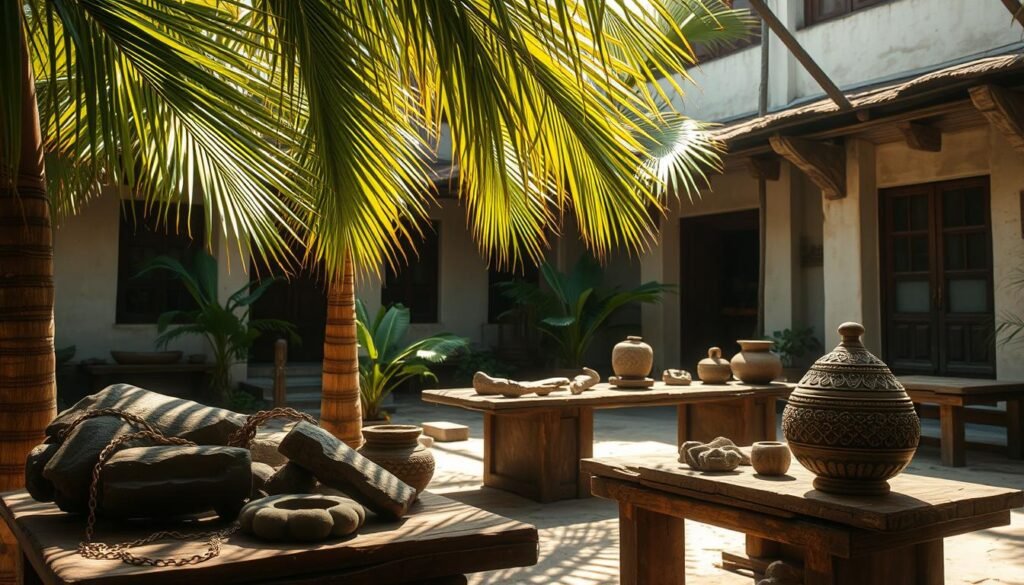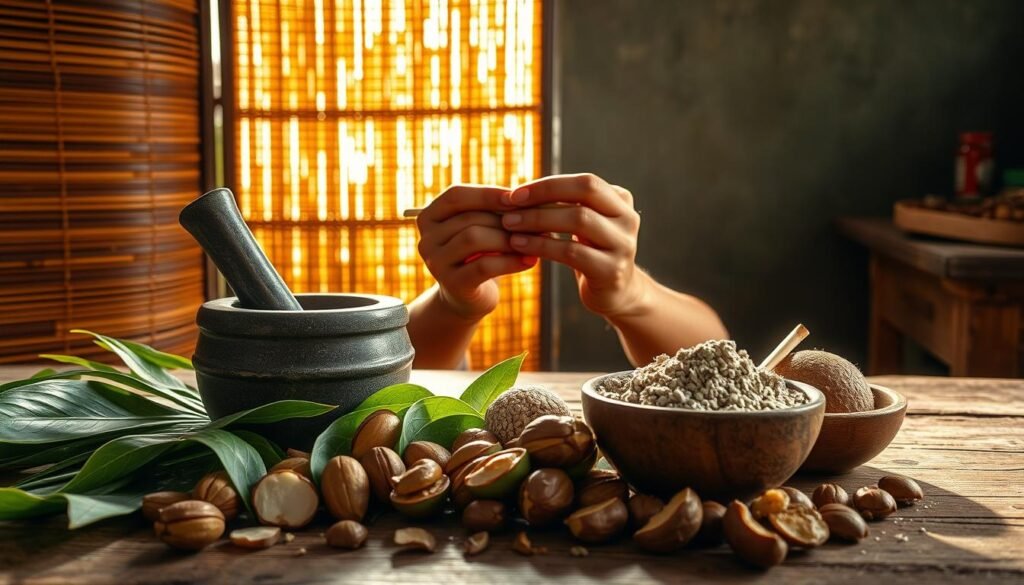Did you know that betel nut chewing dates back thousands of years in the Philippines? This ancient practice, deeply rooted in the region’s culture, played a central role in pre-colonial society. Archaeological findings from Palawan and historical records of Austronesian migrations provide evidence of its widespread use.
In pre-colonial times, the betel quid—a mixture of areca nut, betel leaf, and lime—was more than just a stimulant. It was a symbol of social connection, used in rituals, ceremonies, and even as a gesture of hospitality. The preparation and sharing of this concoction were integral to community bonding.
Excavations in ancient burial sites have uncovered tools and artifacts linked to this tradition, highlighting its importance. The practice was not just a habit but a cultural identity, reflecting the values and customs of the time. Even today, the legacy of betel nut chewing continues to spark discussions about tradition and modernity.
Key Takeaways
- Betel nut chewing has a history spanning thousands of years in the Philippines.
- It was a key part of pre-colonial social and cultural practices.
- Archaeological evidence shows its use in rituals and ceremonies.
- The betel quid was a symbol of hospitality and community bonding.
- Its legacy remains relevant in modern cultural debates.
Historical Origins and Cultural Roots
Archaeological discoveries shed light on the early use of betel nut in pre-colonial societies. Excavations in Palawan and Bohol have uncovered evidence of this practice, dating back thousands of years. Stained dentition and lime containers found in burial sites suggest its ritual significance.

The spread of this tradition is closely tied to Austronesian migrations. As these early settlers moved across Southeast Asia, they carried the practice with them. Trade routes further amplified its reach, making it a common habit in many regions.
Archaeological Evidence and Early Use
Physical artifacts, such as lime containers and tools, highlight the importance of the areca in daily life. These items were often buried with the deceased, symbolizing their role in the afterlife. Early observers noted the stimulatory effect of chewing, which became a key part of social interactions.
Austronesian Migrations and the Spread of the Practice
The migration of Austronesian peoples played a pivotal role in disseminating this custom. From the Philippines, it traveled to Micronesia, South India, and beyond. This widespread adoption underscores its cultural and social significance.
While the practice was celebrated for its health benefits, historical records also hint at potential risks. Despite these concerns, it remained a cherished tradition, deeply embedded in the fabric of pre-colonial life. For more insights into ancient Filipino practices, explore this guide.
Cultural Significance and Social Customs
The cultural fabric of pre-colonial Philippines was deeply woven with unique traditions. Among these, the practice of chewing a specific mixture played a pivotal role in shaping social and religious customs. This mixture, known as the quid, was more than a stimulant—it was a symbol of unity and identity.

Religious and Ritual Ceremonies
In many Filipino communities, the quid was integral to religious ceremonies. It was often offered to deities during rituals, symbolizing respect and devotion. For instance, in the Mansaka balilig ritual, a branch of the tree was anointed with pig’s blood, highlighting its sacred role.
This practice also extended to healing rituals. Elders believed that the quid could ward off evil spirits and restore health. Such beliefs underscore its spiritual significance in pre-colonial society.
Traditions in Filipino Communities
Beyond religious contexts, the quid was a cornerstone of daily social interactions. Offering it to guests was a gesture of hospitality, reflecting the host’s generosity. In some communities, it was even used in courting and marriage negotiations, symbolizing union and commitment.
Despite its cultural reverence, modern studies have raised concerns about its health implications. Prolonged use has been linked to oral cancer, a condition that has sparked debates about its continued practice. However, its role in fostering social bonds remains undeniable.
| Aspect | Role in Society |
|---|---|
| Religious Ceremonies | Symbol of devotion and healing |
| Social Customs | Gesture of hospitality and unity |
| Health Concerns | Linked to oral cancer |
Today, the quid continues to hold cultural importance, especially in rural areas. Its dualistic nature—as both a drug and a cultural symbol—offers a fascinating glimpse into the complexities of Filipino heritage.
Betel Nut: An Integral Part of Pre-Colonial Filipino Life
Across the Asia-Pacific region, the practice of chewing a specific concoction symbolized unity and identity. In pre-colonial Philippines, this tradition was more than a habit—it was a cultural cornerstone. The mixture, often referred to as the quid, played a vital role in rituals, social interactions, and community bonding.

Symbolism and Social Bonding
The areca nut held deep symbolic meaning in Filipino society. It was a marker of identity, often used in ceremonies to signify respect and unity. In many communities, offering the quid to guests was a gesture of hospitality, reflecting the host’s generosity.
This practice also strengthened social bonds. Sharing the mixture during gatherings fostered a sense of belonging. In some regions, it was even used in courting rituals, symbolizing commitment and union.
Traditional Ceremonies and Rituals
The quid was central to many traditional ceremonies. It was offered to deities during religious rituals, symbolizing devotion. In healing practices, elders believed it could ward off evil spirits and restore health.
These rituals highlight the spiritual significance of the practice. They also underscore its role in shaping community identity. Even today, its legacy continues to influence cultural practices in rural areas.
Health Concerns in Modern Context
While the areca nut was celebrated for its cultural importance, modern studies have raised concerns. Prolonged use has been linked to oral cancer, a condition that has sparked debates about its continued practice.
Despite these health risks, the practice remains a cherished tradition for many. Its dualistic nature—as both a cultural symbol and a stimulant—offers a fascinating glimpse into the complexities of Filipino heritage.
| Aspect | Role in Society |
|---|---|
| Symbolism | Marker of identity and unity |
| Social Bonding | Fostered community connections |
| Health Concerns | Linked to oral cancer |
This tradition, deeply rooted in the Asia-Pacific region, continues to be a subject of cultural and health discussions. Its historical significance and modern implications make it a unique aspect of Filipino heritage.
Traditional Methods of Betel Nut Preparation
The preparation of this traditional mixture was an art form in pre-colonial Philippines. It involved precise techniques and tools, reflecting the cultural significance of the practice. The process was not just about creating a stimulant but also about preserving a tradition that connected communities.

Processing and Preparation Techniques
The first step in the preparation was slicing the nut into thin strips. This allowed for easier chewing and better absorption of the active ingredients. Special cutters were often used to handle the hard, dried nuts, showcasing the craftsmanship involved.
Once sliced, the strips were carefully rolled into betel leaves. This step required skill, as the leaves had to be fresh and pliable. The addition of slaked lime was crucial, as it activated the substance and enhanced its effects.
The Role of Betel Leaves and Slaked Lime
Betel leaves played a dual role in the preparation. They served as a natural wrapper and added their own flavor to the mixture. The leaves were also believed to have medicinal properties, further elevating their importance.
Slaked lime, made from burnt seashells, was another key ingredient. It acted as a catalyst, releasing the active compounds in the nut. This combination created a potent mixture that was both stimulating and culturally significant.
- The nut was sliced into thin strips for easier chewing.
- Betel leaves were used as natural wrappers, adding flavor and medicinal benefits.
- Slaked lime activated the substance, enhancing its effects.
- Occasionally, tobacco and spices were added to modify the flavor and potency.
These traditional methods have influenced modern practices, even as health concerns about disease risks have emerged. The art of preparation remains a testament to the cultural heritage of the Philippines.
Health Implications and Risks in Historical Context
Throughout history, the practice of chewing a specific mixture has been linked to both cultural significance and health concerns. While it played a vital role in social and ritual practices, historical evidence suggests it also posed risks to users.

Oral and Systemic Effects Observed in History
Historical accounts reveal that regular use of this mixture often led to oral health issues. Stained teeth, gum disease, and lesions were common among habitual users. Beyond oral effects, systemic impacts like increased heart rate were also documented.
Modern studies have further linked the ingestion of the areca seed to more severe conditions. These include oral submucous fibrosis, a precancerous condition, and even oral cancer. The addition of lime in the preparation process has been identified as a contributing factor to these risks.
Long-Term Impact and Dependency Issues
Over time, the practice has been associated with dependency. Users often reported difficulty quitting, citing both physical and psychological reliance. This dependency has been compared to other psychoactive substances, highlighting its addictive nature.
Globally, the world has seen a rise in health issues linked to this tradition. From Southeast Asia to the Pacific, the long-term effects have sparked public health debates. For more detailed insights, explore the health risks of betel nut.
While the practice remains culturally significant, its health implications cannot be ignored. Balancing tradition with modern health awareness is crucial for addressing these risks effectively.
The Multifaceted Impact on Daily Life
The practice of chewing a specific mixture shaped the daily lives of many in pre-colonial societies. It was not just a habit but a part of their cultural and social fabric. This tradition influenced routines, health practices, and even community interactions.

Dietary Uses and Medicinal Traditions
For many users, this mixture was more than a stimulant. It was integrated into their diet, often combined with traditional foods and medicinal herbs. In some cultures, it was believed to aid digestion and provide energy.
In India, the practice was deeply tied to Ayurvedic traditions. It was used to balance bodily humors and treat ailments. Similarly, in the Philippines, it played a role in indigenous healing practices, often used to ward off illnesses.
This mixture also had ceremonial significance. It was offered during rituals to symbolize respect and unity. Its use in healing ceremonies highlights its spiritual and medicinal importance.
Social Behavior and Community Interactions
On a population level, the habit fostered social bonds. Sharing the mixture during gatherings was a gesture of hospitality. In some communities, it was even used in courting rituals, symbolizing commitment.
Despite its cultural reverence, modern studies have raised concerns about its health implications. Prolonged use has been linked to oral cancer, a condition that has sparked debates about its continued practice.
| Aspect | Role in Daily Life |
|---|---|
| Dietary Uses | Integrated into meals and medicinal practices |
| Medicinal Traditions | Used in Ayurvedic and indigenous healing |
| Social Interactions | Fostered community bonds and hospitality |
| Health Concerns | Linked to oral cancer |
Today, the practice continues to hold cultural importance, especially in rural areas. Its dualistic nature—as both a cultural symbol and a stimulant—offers a fascinating glimpse into the complexities of heritage. For more insights, explore this study on its historical and health implications.
Betel Nut in Trade and Economy
The exchange of a culturally significant substance played a pivotal role in economic systems. In pre-colonial times, this stimulant was not just a personal habit but a valuable commodity. Its trade connected communities and fueled local economies across the country.

Local and Regional Economic Influence
Historical records show that this substance was a cornerstone of regional commerce. Its preparation form—often sliced and wrapped—made it easy to transport and trade. Markets thrived as demand grew, with traders moving it across vast distances.
In many areas, it became a symbol of wealth and hospitality. Offering it to guests was a gesture of goodwill, while its sale provided livelihoods for countless families. This trade also fostered economic relationships between regions, creating a network of interdependence.
Commercial Aspects in Pre-Colonial Markets
The commercial practices surrounding this substance were well-organized. Traders packaged it carefully to preserve its quality, often using leaves or containers. Its sale was a common sight in bustling markets, where it was exchanged for goods or currency.
Its economic impact extended beyond local markets. In some cases, it was traded internationally, connecting the Philippines with other countries in Asia and the Pacific. This trade not only boosted economies but also facilitated cultural exchange.
“The trade of this substance was more than commerce—it was a bridge between cultures and economies.”
Today, the legacy of this trade continues to influence perceptions and regulations. While modern concerns about health risks like fibrosis have emerged, its historical significance remains undeniable. For a deeper understanding of its economic impact, explore this study.
Lessons from Historical Use for Modern-Day Perspectives
Understanding historical practices can offer valuable insights for modern health discussions. The tradition of chewing a specific mixture, deeply rooted in pre-colonial societies, has evolved over time. Today, it serves as a case study for examining contemporary health challenges and regulatory measures.

Comparative Insights with Contemporary Practices
Historically, this practice was a cultural cornerstone, often used in rituals and social interactions. Modern habits, however, have shifted due to changes in additives and preparation methods. For instance, the introduction of tobacco as a type of additive has significantly altered its health impact.
Cultivation of the areca palm has also changed. Traditional methods have been replaced by industrial processes, affecting the quality and potency of the product. These shifts highlight the need for updated regulations to address current health risks.
Implications for Public Health Debates Today
Modern research links this practice to severe health issues, including oral cancer and cardiovascular disease. These findings have sparked debates about its continued use, especially in regions where it remains prevalent. Lessons from history can inform these discussions, emphasizing the importance of balancing tradition with health awareness.
For example, studies show that the factor of prolonged use increases the risk of oral submucous fibrosis. This condition is a precursor to cancer, underscoring the need for public health interventions. Additionally, the role of lime in the preparation process has been identified as a contributing factor to these risks.
| Aspect | Historical Context | Modern Implications |
|---|---|---|
| Additives | Natural ingredients like betel leaf | Introduction of tobacco and chemicals |
| Health Risks | Limited awareness of long-term effects | Linked to oral cancer and cardiovascular disease |
| Regulations | Nonexistent | Increasing calls for stricter measures |
Historical evidence also highlights the cultural significance of this practice across different islands and regions. While it remains a cherished tradition in some areas, its health implications cannot be ignored. For a deeper understanding of its cultural and health impacts, explore this study.
Ultimately, the lessons from history can shape future public health policies. By understanding the evolution of this practice, society can better address its challenges while preserving its cultural heritage.
Conclusion
The practice of chewing areca catechu has left a lasting mark on Philippine history. For centuries, it shaped social customs, rituals, and community bonds. Its role in daily life extended beyond the body, influencing traditions and economic activities.
Originating in the east, this practice evolved over time, blending cultural significance with modern health concerns. While it fostered unity and hospitality, it also posed risks, including oral health problems. This duality highlights its complex legacy.
Today, the historical use of areca catechu offers valuable lessons. By studying its impact, we can better address modern health challenges while respecting cultural heritage. Continued research and awareness can guide future policies, ensuring a balance between tradition and well-being.
For more insights into the historical and cultural significance of this practice, explore this study. Understanding its past can help shape a healthier future.
FAQ
What is the historical significance of betel nut chewing in the Philippines?
Betel nut chewing was deeply rooted in pre-colonial Filipino culture, serving as a symbol of social bonding and an integral part of rituals and traditions.
How did betel nut chewing spread across the Philippines?
The practice was introduced through Austronesian migrations and became widespread due to its cultural and social importance in Filipino communities.
What role did betel nut play in religious ceremonies?
It was often used in rituals as an offering or to signify unity and respect during spiritual and communal gatherings.
How was betel nut traditionally prepared?
The seed was typically wrapped in betel leaves and mixed with slaked lime, creating a chewable mixture that was central to the practice.
What were the health implications of betel nut chewing in pre-colonial times?
While it was valued for its stimulant effects, historical evidence suggests it also led to oral health issues and dependency among users.
How did betel nut influence the economy in pre-colonial Philippines?
It played a significant role in local and regional trade, contributing to the economy through its cultivation and exchange in markets.
What can modern societies learn from historical betel nut use?
Understanding its cultural and health impacts offers insights into contemporary public health debates and the balance between tradition and well-being.
Source Links
- Betel Container
- The Uses of Buyo and Bonga in Ancient Visayas
- Betel | Nut, Leaf, Quid, Uses, Drug, Cultivation, & Facts | Britannica
- A Bite of History: Betel Chewing in Singapore
- Betel nut chewing
- In Focus: Hidden in the Heart – National Commission for Culture and the Arts
- To Chew or Nut to Chew: An Ethnographic Study of the Socio-Cultural Role of Betel Nut (Areca catechu) in the Life of the Ilocanos
- Betel Nut and Betel Leaf Strengthening Social Relations through the Tradition of Chewing Betel in the Islamic Community in Kao Village, North Halmahera
- Sociocultural Factors that Affect Chewing Behaviors among Betel Nut Chewers and Ex-Chewers on Guam
- Betel Nut and Betel Leaf: Strengthening Social Relations through the Tradition of Chewing Betel in the Islamic Community in Kao Village, North Halmahera
- Betel nut products and preparations
- AVAILABILITY AND CHARACTERISTICS OF BETEL PRODUCTS IN THE U.S
- Adverse Health Effects of Betel Quid and the Risk of Oral and Pharyngeal Cancers
- Betel Nut Chewing Increases the Risk of Metabolic Syndrome and Its Components in a Large Taiwanese Population Follow-Up Study Category: Original Investigation
- Frontiers | Cumulative Betel Quid Chewing and the Risk of Significant Liver Fibrosis in Subjects With and Without Metabolic Syndrome
- A Positive Relationship between Betel Nut Chewing and Significant Liver Fibrosis in NAFLD Subjects, but Not in Non-NAFLD Ones
- Biological Effects and Biomedical Applications of Areca Nut and Its Extract
- Association of Betel Nut with Carcinogenesis: Revisit with a Clinical Perspective
- Evaluation of Various Preservation Methods Betel Nut in the CNMI
- Betel nut providing added benefit to farmers
- Betel-quid and Areca-nut Chewing – Betel-quid and Areca-nut Chewing and Some Areca-nut-derived Nitrosamines
- Frontiers | Social media, peer norms, and betel nut susceptibility and use: Evidence from early adolescents in Guam
- 31_3_417.pdf
- IARC Monographs Programme finds betel-quid and areca-nut chewing carcinogenic to humans

